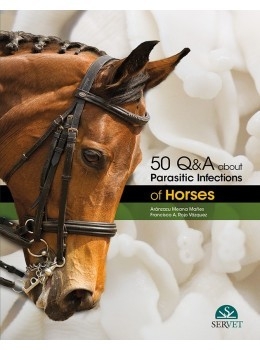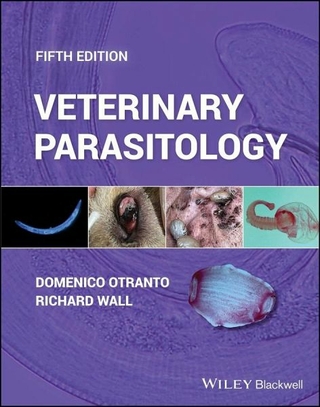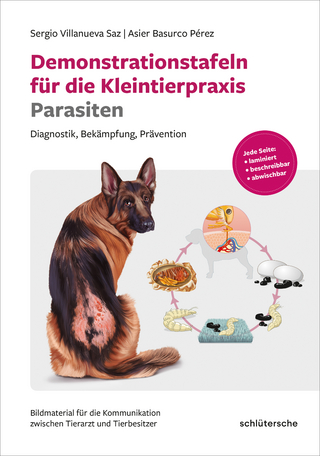
50 Q&A about Parasitic Infections of Horses
Servet Publishing (Verlag)
978-84-17225-82-7 (ISBN)
- Titel nicht im Sortiment
- Artikel merken
Zu diesem Buch erhalten Sie kostenlos ein eBook dazu.
This book, organised into chapters divided by organ, presents real-life situations that deal with parasites of the horse in professional veterinary practice. Its images and diagrams – around 300 altogether – render it something of a parasitology atlas.
Aránzazu Meana Mañes earned her degree and PhD in veterinary medicine from the Complutense University of Madrid (UCM), where she is full professor at the Department of Animal Health of the Faculty of Veterinary Medicine. She is also a Diplomate of the European Veterinary Parasitology College. She has worked as a veterinary surgeon of small animals in a private clinic. Her research activity focuses on the pathophysiology and epidemiology of major parasitic diseases of domestic animals (gastrointestinal and hepatic helminths of herbivores, equine and bovine piroplasmosis), and on methods of control (chemoprophylaxis, anthelmintic resistance, and genetic resistance) of parasitic diseases of domestic and wild animals. She has published numerous research papers on parasitic diseases of animals in international parasitology and veterinary journals and has presented numerous communications to national and international parasitology congresses. She has been a visiting fellow at the Departments of Veterinary Medicine of the University of Glasgow and the Faculty of Veterinary Medicine, University of Cambridge (United Kingdom). She has worked as assistant director of the Department of Animal Health of the UCM, and has sat on expert committees of the Spanish Ministry of Health, Education and Science, and the Ministry of Agriculture, Fisheries, and Food. She is a member of the Spanish Society of Parasitology (SEP) and the World Association for the Advancement of Veterinary Parasitology, and is a Founding Diplomate of the European Veterinary Parasitology College (EVPC).
Francisco Rojo Vázquez earned his degree and PhD from the Faculty of Veterinary Medicine of León, University of Oviedo. He is a professor at the universities of Salamanca (Faculty of Pharmacy), Madrid (Faculty of Veterinary Medicine), and León (Faculty of Veterinary Medicine), and a diplomate of the European Veterinary Parasitology College. He has worked as a scientific collaborator with the CSIC and as a visiting professor at the Faculty of Veterinary Medicine of Philadelphia (USA), director of the Animal Health Research Centre (CISA) in Valdeolmos (Madrid), and general deputy director of research and technology at INIA, Ministry of Science and Innovation. He currently works as a researcher at the Mixed Institute (CISC-ULE) of Mountain Livestock Farming (IGM) in León. His research activity focuses on the pathophysiology, epidemiology, and immunology of parasitic diseases of domestic animals and the control (chemoprophylaxis, anthelminthic resistance, genetic resistance) of parasitic diseases of domestic animals. He has authored numerous research papers on various aspects of parasitic diseases of animals and humans, published in international parasitology and veterinary journals, and presented communications to national and international parasitology congresses. He has spent time at the Department of Parasitology, Ministry of Agriculture, Fisheries & Food, Central Veterinary Laboratory, Weybridge (United Kingdom), the Department of Parasitology, Moredun Research Institute, Edinburgh (Scotland), and the Large Animal Hospital, University of Pennsylvania School of Veterinary Medicine, Philadelphia (USA). He has held numerous university positions and is a member of the major parasitology and veterinary associations. He is a founding diplomate of the European Veterinary Parasitology College (EVPC).
I. Q & A Endoparasites of the digestive system
Introduction
1. What are gasterophilids?
2. How are gasterophilids transmitted?
3. What are the effects of Gasterophilus?
4. How can we tell if a horse is parasitised by gasterophilids?
5. How is Strongyloides transmitted?
6. How do foals become infected with Parascaris if the adults are resistant and do not shed eggs?
7. What are the consequences of Parascaris infection?
8. Why is it so difficult to eliminate Parascaris from a farm?
9. How are Parascaris transmitted?
10. Are any Parascaris species resistant to anthelmintics?
11. Can cestodes cause the death of their host?
12. How is the risk of cestodiasis avoided?
13. How important a disease is strongyloidiasis in equids?
14. What are the most pathogenic strongyles?
15. Can Strongylus vulgaris larvae be observed in the mesenteric arteries?
16. Which nematode migrates via the right parietal peritoneum?
17. How and when are equids infected by strongyle larvae?
18. How does thromboembolic colic occur?
19. What is exercise-related lameness of parasitic origin?
20. What pathology do cyathostomins cause?
21. Are any equine strongyles resistant to anthelmintics?
22. How is oxyuriasis diagnosed?
23. Can more than one pinworm species affect equids?
24. Is Fasciola commonly found in equids?
25. Which parasites are implicated in diarrhoea of newborn animals?
II. Q & A Endoparasites of the respiratory system
Introduction
26. How is dictyocaulosis diagnosed in a horse?
27. Why do donkeys transmit dictyocaulosis to horses?
28. Why are so many eosinophils produced in cases of parasitic bronchitis?
29. What fly larvae can cause catarrhal processes in horses?
30. What parasite can cause laryngeal stridor?
III. Q & A Systemic endoparasites
Introduction
31. What is the best method to diagnose piroplasmosis?
32. Can piroplasms cause death?
33. Why is piroplasmosis not fatal in horses in endemic areas?
34. Why do animals infected by Theileria equi continue to carry the disease?
35. Are hydatid cysts of horses the same as those found in other species?
36. Can horses transmit trichinellosis?
37. What is dourine?
38. Can horses transmit toxoplasmosis?
IV. Q & A Parasitic infections of the skin
Introduction
39. What types of mites parasitise equids?
40. Are mites easily visualised?
41. Can rabbits transmit mange to horses?
42. How is leg mange diagnosed?
43. Are males required in order for lice to multiply?
44. Why are ticks so abundant?
45. What diseases do ticks transmit?
46. Are ticks found during winter?
47. Can severe allergic reactions be caused by mosquitoes?
48. What diseases do flies and mosquitoes transmit?
49. Why does the forest fly not fly?
50. Which parasite impairs covering in stallions?
| Erscheinungsdatum | 22.11.2018 |
|---|---|
| Verlagsort | Zaragosa / Spanien |
| Sprache | englisch |
| Maße | 220 x 280 mm |
| Gewicht | 1084 g |
| Einbandart | gebunden |
| Themenwelt | Veterinärmedizin ► Klinische Fächer ► Parasitologie |
| Veterinärmedizin ► Pferd ► Krankheitslehre | |
| Schlagworte | Parasitologie • Pferde; Veterinärmedizin • Veterinärmedizin / Mikrobiologie,Parasitologie,Inf |
| ISBN-10 | 84-17225-82-X / 841722582X |
| ISBN-13 | 978-84-17225-82-7 / 9788417225827 |
| Zustand | Neuware |
| Haben Sie eine Frage zum Produkt? |
aus dem Bereich


